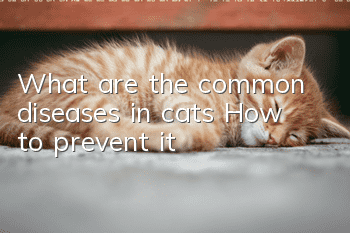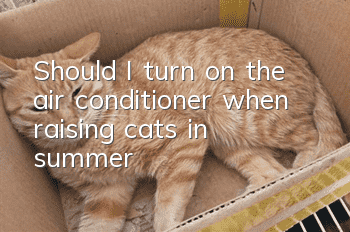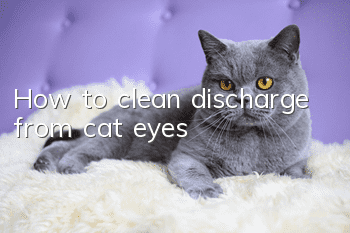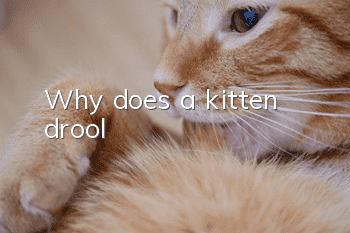What are the common diseases in cats? How to prevent it?

Friends who keep cats will inevitably encounter times when they get sick. As the saying goes, "prevention is better than cure", so you should take good care of your cat in daily life to reduce the occurrence of diseases. Otherwise, when the cat's disease is serious, treatment may not be possible. You can’t save its life! Let’s take a look at the top ten common diseases in cats, so you can take targeted prevention!
1. External parasites
① Fleas: Red stains are found on the skin caused by their feces being wetted.
Treatment method: You can use flea killer or flea collar, and apply it on the cat's feet, back, tail, and buttocks at the base of the hair. Avoid getting wounds or eyes. If there is redness, hair loss, or allergies on the skin, , take a bath in time to remove drug residues or take it to a pet care facility for disposal.
Prevention: Use more flea killers when you go out to avoid bringing fleas home.
②Ear mites: Ear mites are easier to identify. Cats have black greasy dirt in their ears and they often scratch the back of the ears with their claws.
Treatment: Ear oil drops.
2. Internal parasites
Fleas serve as intermediate hosts for parasites and can be transmitted to humans. So be sure to deworm your body.
Treatment method: Use internal deworming tablets for cats and deworm regularly. In the days after taking the medicine, the cat litter should be changed frequently to avoid secondary infection by insect eggs.
3. Feline viral rhinotracheitis
Symptoms of kittens: The incubation period is 2-6 days. Kittens are more susceptible than adult cats, with paroxysmal coughing, sneezing, tearing, conjunctivitis, loss of appetite, weight loss, depression, increased nasal secretions, and initially serous , and later became purulent.
Symptoms of adult cats: Infection is characterized by congestion of the cornea of the eyes, difficulty in eating in the mouth, and constant discharge of secretions from the mouth with a foul odor. Chronic sinusitis, ulcerative conjunctivitis and ophthalmitis are the main features. Inflammation in the nasal cavity can narrow the respiratory tract, leading to difficulty breathing and suffocation.
Treatment method: antibiotics, and simultaneous treatment if there are other complications.
IV. Enteritis
Pay attention to whether it is common enteritis or viral or infectious enteritis. Gastroenteritis and mixed inflammation are more common when diagnosed in the hospital.
Symptoms: Enteritis (mainly manifested as diarrhea), duodenal inflammation (mainly manifested as vomiting), small intestinal mucosal bleeding (mainly manifested as black or dark red stool), large intestine and colon mucosal bleeding (mainly manifested as blood or black stool) blood clots). Enteritis due to bacterial infection (mainly manifested by elevated body temperature, depression, decreased appetite orIn Feijue, the animals showed dehydration, weight loss, acidosis, bowed waist, abdominal pain, and sensitivity to touch the abdominal wall). Chronic enteritis (mainly characterized by mild systemic symptoms, but repeated diarrhea, and animals showing dehydration, weight loss, and malnutrition).
Treatment: ① Take oral rehydration salt to prevent dehydration, provide nutritious and easily digestible food, and take oral probiotics for Modi cats to improve the balance of gastrointestinal flora and regulate gastrointestinal function. ②Anti-inflammatory and antibacterial. ③ Symptomatic treatment, hemorrhagic enteritis should pay attention to hemostasis. ④ Anthelmintics should be given for enteritis caused by parasites.
5. Urinary tract infection
It is caused by bacteria, urethral obstruction, urethral stones and "idiopathic" factors. It is characterized by frequent urination, difficulty in urination, or blood in the urine.
Treatment methods: ①Severe surgery. ②Use anti-inflammatory drugs for bacterial infection. ③ Catheterization. ④Supplement taurine, but be careful not to cause metabolic urinary poisoning due to excessive acidification, and feed prescription food.
6. Cat ringworm
Due to the long treatment cycle, it is difficult to cure, easily contagious, and easy to relapse. It can also be transmitted to humans, causing itching and peeling of human skin. Ringworm is more common in malnourished and sickly cats.
Symptoms: Cat ringworm is a fungal infection of the skin disease. It mostly appears on the face, limbs and tail. It appears as round or oval ringworm spots, covered with gray scales. Purple fluorescent spots can be seen when irradiated with ultraviolet light. . The coat is rough, the ringworm spots are coated and the hair falls off, and it is extremely itchy and goes away after repeated scratching, resulting in alopecia areata.
Prevention: Supplementing nutrition, enhancing nutrition for cats, especially increasing the intake of B vitamins, will help improve the cat’s resistance, thereby speeding up the treatment of cat ringworm. In addition, cat owners can also take some vitamin tablets to prevent infection.
Treatment: Go to a pet hospital for formal treatment.
7. Stomatitis
The cause is quite complex, and oral inflammation can be caused by a variety of reasons.
Symptoms: Specific symptoms, feeling hungry, wanting to eat but not daring to eat. When food enters the mouth, it stimulates the inflammatory site and causes pain. The affected cat suddenly howls and runs away evadingly. There is salivation in the mouth, and some people stick their tongues out of the mouth. Those who last longer will gradually lose weight.
Treatment: Go to a pet hospital for formal treatment.
8. Infectious peritonitis
It is a chronic progressive infectious disease in cats caused by feline infectious peritonitis virus. It is most common in cats aged 1 to 2 years old and older cats. Purebred cats are more common in domestic cats.
Symptoms: loss of appetite or intermittent anorexia. body temperatureThe temperature rises to 39.7℃-41℃, and obvious abdominal girth enlargement can be seen after 7-40 days. As the abdominal girth increases, dyspnea, anemia, and weight loss may occur. Cats may collapse and die after a few weeks of illness.
Clinical diagnosis: A large amount of ascites accumulates, and there is generally no obvious pain when the abdominal wall is palpated.
Treatment: The pathogen belongs to coronavirus and can be killed by commonly used disinfectants.
9. Cat plague
Feline distemper is also known as feline panleukopenia or feline infectious enteritis. It is a highly contagious infectious disease. Cats with incomplete or unvaccinated vaccinations are prone to feline distemper. It mainly occurs in kittens under one year old, especially kittens aged 3-5 months. There are large amounts of viruses in the vomit, feces, urine, saliva, nasal and eye secretions of sick cats. Even sick cats can still shed the virus in their feces and urine for weeks to more than a year after recovery. These excretions and secretions contaminate feed, drinking water, utensils or the surrounding environment, which can spread the disease. It is the most common and very dangerous infectious disease in domestic cats.
Symptoms: poor energy, long sleep time, rough and messy coat, indifferent to owner’s call and environment. Refusal to eat or loss of appetite, and gradually stop eating after the onset of the disease. The body temperature rises to above 40°C, lasts for about 24 hours, then drops to normal temperature, but can rise again after 2-3 days, showing a typical multiple-phase heat type. Vomiting is its main characteristic. Diarrhea with bloody watery stools, severe dehydration, and rapid weight loss. Dehydration and secondary bacterial infection are often causes of sudden death.
Other complications: including oral ulcers, bloody diarrhea, jaundice, and generalized intravascular coagulation syndrome. If the course of the disease exceeds 5-7 days and no fatal complications occur, recovery is often possible; the number of white blood cells will return to normal within 24-48 hours after the course of the disease exceeds.
Diagnosis of the Pet Clinic: The blood test of the sick cat showed a sharp decrease in white blood cells as the main feature. (The level drops below 4000 cells/ml 4-6 days after infection).
Treatment method: 1. Isolate from other pets to avoid infection. 2. Infusion to prevent dehydration, adjust body fluid balance and correct acidosis. 3. Improve vomiting symptoms. 4. Give broad-spectrum antibiotics to prevent secondary bacterial infections. 5. Plasma transfusion is given in case of severe anemia.
Prevention method: Inject cat plague vaccine.
Note: During the treatment period, due to the ingestion of a large amount of antibiotics, the cat's normal digestive flora is also destroyed during the treatment. The cat needs to be given some drugs to regulate digestion, such as probiotics for Modi cats, probiotics Take it separately from antibiotics at least 2-3 hours apart. In the later stages of recovery, the diet should mainly consist of light foods. To supplement nutrition, you can eat cat nutritional paste, which has more comprehensive nutrition and is easier to digest.
10. Diabetes
It is common in cats over 8 years old and is a chronic disease.
Symptoms: Polydipsia, polydipsia and polyuria, anorexia, poor energy (symptoms of acute pancreatitis). Later, eye diseases such as corneal ulcers and cataracts may occur.
Diagnosis: Blood tests showed elevated blood sugar and blood ketones. Urine test showed high urine sugar.
Treatment: ① Inject insulin according to body weight. Until the diabetes stops and the symptoms of ketoacidosis are relieved. ② Inject potassium chloride. ③Inject sodium bicarbonate. ④ Pay attention to controlling the glucose content in food.
- What should I do if a cat runs away when it sees its owner approaching?
- There are black particles on the cat
- What causes a cat’s black chin? The real cause of a cat’s black chin!
- What should I pay attention to when fostering cats?
- How to prevent rickets in cats with folded ears?
- How many months does it take for a kitten to get teeth?
- Can cats also get fatty liver? What are the symptoms of fatty liver?
- How to choose a cat climbing frame? Three key points when purchasing a cat climbing frame!
- Cat's body odor is very strong and smells bad? Maybe it's because of these reasons!
- Why do cats love to lick their fur? What are the benefits of cat licking?



